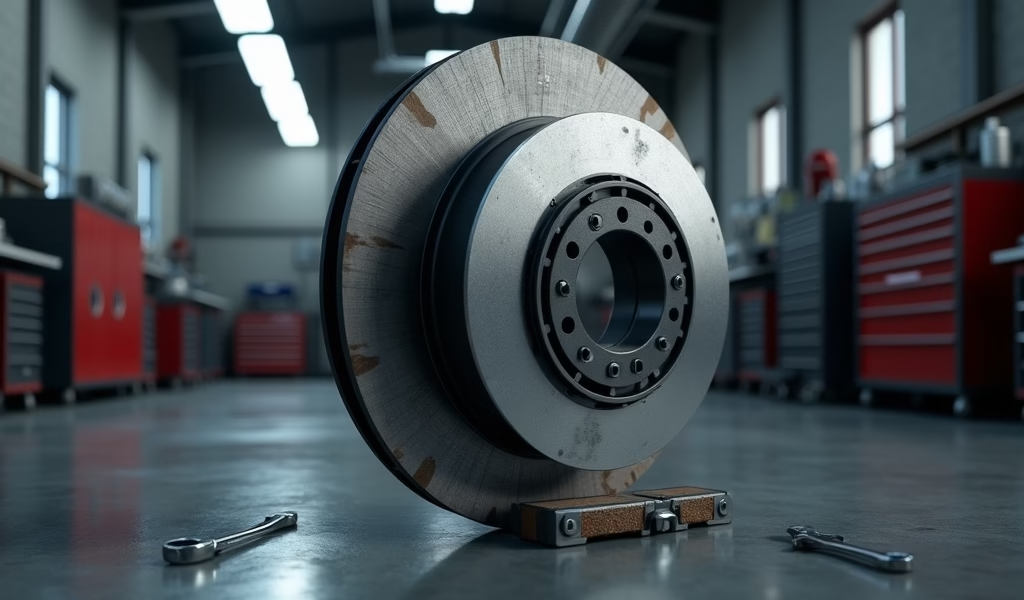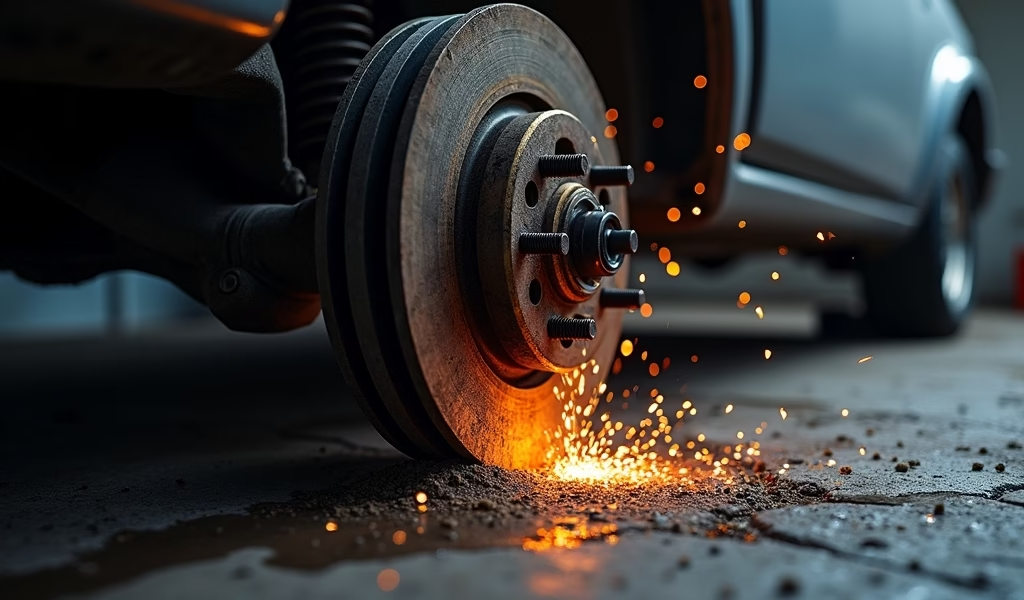Overview
This article explores the critical importance of brake pad backing plate thickness in vehicle safety and braking performance, covering proper measurement techniques, inspection routines, selection criteria, installation methods, and damage assessment. It emphasizes that following manufacturer specifications for backing plate thickness is essential for optimal braking system function, with regular inspections recommended every 10,000 miles for average driving conditions and more frequently for severe conditions.
Table of Contents
- Understanding Brake Pad Backing Plates
- Importance of Backing Plate Thickness
- Measuring Backing Plate Thickness
- Tip 1: Regular Inspection Routines
- Tip 2: Choosing the Right Backing Plate
- Tip 3: Proper Installation Techniques
- Tip 4: Dealing with Wear and Damage
- Tip 5: Manufacturer Specifications
- Conclusion
- Frequently Asked Questions
Understanding Brake Pad Backing Plates
When we talk about brake pad backing plate thickness, we’re discussing a crucial component of your vehicle’s braking system that often doesn’t get the attention it deserves. As a mechanic who’s spent countless hours working on braking systems, I can tell you that these metal plates are the unsung heroes of your brake pads.
The backing plate is the metal portion of the brake pad that supports the friction material (the part that actually contacts your rotor). Think of it as the foundation of your brake pad—providing structure, heat dissipation, and a mounting point for the entire assembly. Without a properly functioning backing plate, even the highest-quality friction material won’t perform correctly.
Most backing plates are made from steel or other metal alloys, designed to withstand the extreme heat and pressure generated during braking. Their thickness typically ranges from 4mm to 7mm, depending on the vehicle make, model, and braking system design. This seemingly small component plays an outsized role in your vehicle’s stopping power and safety.
Unlike the drum brake shoe lining thickness, which has its own set of considerations, backing plate thickness for disc brakes requires specific attention due to the different braking dynamics at play.
Importance of Backing Plate Thickness
Why should you care about something as seemingly minor as brake pad backing plate thickness? Let me break it down in plain terms: it directly affects your safety on the road.
First and foremost, backing plate thickness affects heat management. During heavy braking, temperatures can reach over 500°F. A properly sized backing plate helps dissipate this heat, preventing brake fade and ensuring consistent stopping power. Too thin, and you risk warping or even complete failure under extreme conditions.
Structural integrity is another critical factor. The backing plate supports the friction material and must withstand tremendous forces during braking. An inadequate thickness can lead to flexing, cracking, or separation of the friction material from the plate—potentially resulting in catastrophic brake failure.
Noise and vibration dampening also depend on proper backing plate specifications. Insufficient thickness can contribute to squealing, grinding, or pulsating brakes that not only drive you crazy but can indicate developing problems.
Finally, backing plate thickness affects overall pad life. The right thickness contributes to even wear patterns and maximum service life, giving you more value for your money while maintaining safety. According to research from the Society of Automotive Engineers, optimal backing plate thickness can extend brake pad life by up to 15%.

Measuring Backing Plate Thickness
Checking your brake pad backing plate thickness doesn’t require exotic tools, just a bit of care and precision. Here’s how I approach this task in my shop, and how you can do it at home if you’re comfortable working on your vehicle.
First, you’ll need a quality digital caliper—they’re more precise than the dial type and relatively affordable these days. Make sure your vehicle is safely supported on jack stands with the wheels removed for proper access to the brake components.
Once you have access to your brake pads, carefully remove them following your vehicle’s service manual guidelines. Clean the backing plate of any debris or corrosion that might affect your measurements. I like to use a wire brush followed by brake cleaner for this step.
To get an accurate measurement:
- Measure at multiple points (at least three) across the backing plate to check for uneven wear
- Avoid measuring areas with obvious damage or significant corrosion
- Record your findings for future reference and comparison
- Compare with manufacturer specifications (usually found in service manuals)
Most passenger vehicles have backing plates ranging from 4-7mm thick, but what’s important is how they compare to the original specifications. A reduction of more than 15-20% from original thickness is typically cause for replacement.
While measuring brake components, it’s also good practice to check your disc brake rotor thickness to ensure the entire system is in good condition.
Tip 1: Regular Inspection Routines
Developing a consistent inspection routine for your brake pad backing plates will save you headaches (and potentially serious safety issues) down the road. I recommend incorporating backing plate checks into your regular brake maintenance schedule rather than treating them as an afterthought.
For the average driver, inspecting backing plates every 10,000 miles or annually (whichever comes first) provides a good balance between vigilance and practicality. However, if you frequently drive in mountainous terrain, tow heavy loads, or have a performance-oriented driving style, more frequent inspections every 5,000-7,000 miles would be prudent.
Here’s what a thorough backing plate inspection should include:
- Visual examination for cracks, warping, or separation from friction material
- Checking for unusual wear patterns or thinning along edges
- Looking for signs of overheating (bluing or discoloration)
- Inspecting for corrosion, particularly in areas where salt is used on roads
- Verifying that anti-rattle clips and shims are intact and properly positioned
Remember that backing plate issues often manifest as symptoms you can detect while driving. Pay attention to new noises, vibrations, or changes in braking feel. These could indicate backing plate problems before they become visible during inspection.
Creating a simple maintenance log to track measurements over time can help you identify trends and anticipate when replacement might be necessary. This proactive approach, as recommended by the NHTSA, can prevent unexpected brake failures and extend the life of your entire braking system.
Tip 2: Choosing the Right Backing Plate
Not all backing plates are created equal, and selecting the right one for your vehicle and driving style can make a significant difference in braking performance and safety. I’ve seen plenty of brake issues stemming from inappropriate backing plate specifications, so let me share some guidance.
First and foremost, always match or exceed the original equipment manufacturer (OEM) specifications for thickness. While it might be tempting to save a few dollars on budget brake pads with thinner backing plates, the potential consequences aren’t worth the risk. Thicker isn’t always better either—backing plates that exceed specifications can cause fitment issues or alter the braking characteristics.
Consider your driving conditions and habits when selecting replacement pads. If you frequently drive in mountainous areas or carry heavy loads, look for brake pads with backing plates specifically designed for high-heat scenarios. These typically feature additional heat-dissipating features like slots or thermal barriers between the friction material and the plate itself.
Material quality matters tremendously. High-quality steel backing plates with proper anti-corrosion coatings will last longer and perform more consistently than cheaper alternatives. Some premium brake pads even use specialized alloys or composite backing plates designed for specific performance characteristics.
Don’t forget about noise-reduction features. Many quality backing plates include integrated noise-dampening layers or designs that reduce brake squeal. This might seem like a comfort issue, but persistent noise can also indicate potential problems with backing plate resonance that could affect performance.
When replacing brake pads, take the opportunity to compare the backing plates of your worn pads with the new ones. They should appear similar in thickness, material, and design features. Significant differences might indicate you’re not getting an appropriate replacement for your vehicle.

Tip 3: Proper Installation Techniques
Even the highest-quality backing plates won’t perform properly if installed incorrectly. After replacing countless sets of brake pads over my career, I’ve developed some installation practices that help ensure optimal backing plate performance.
Before installation, always thoroughly clean the caliper bracket where the backing plate will make contact. Any debris, rust, or old adhesive can prevent proper seating and cause uneven pressure distribution. I use a wire brush followed by brake cleaner to ensure spotless contact surfaces.
Apply a thin layer of high-temperature brake lubricant to the backing plate edges and contact points—but never on the friction surface! This reduces noise and allows the backing plate to move slightly as needed during normal operation. The lubricant also provides additional corrosion protection in these critical areas.
When installing the brake pads, ensure that any anti-rattle clips, shims, or hardware are positioned exactly as specified in the service manual. These components play a crucial role in maintaining proper backing plate position and preventing unwanted movement that can cause accelerated wear.
Be particularly careful when compressing the caliper piston back into its bore. Apply pressure evenly to avoid twisting forces that could damage the backing plate. I prefer to use a proper caliper compression tool rather than makeshift methods like C-clamps that can apply uneven pressure.
After installation, perform a proper bed-in procedure for new brake pads, which helps transfer a thin layer of friction material to the rotor and establishes optimal contact between components. This process, which typically involves a series of moderate stops from around 30-40 mph, helps ensure the backing plate settles into its proper position.
Finally, recheck all mounting hardware after about 100 miles of driving. Vibrations and heat cycles can sometimes cause fasteners to loosen slightly, which can affect backing plate stability and performance.
Tip 4: Dealing with Wear and Damage
Even with proper selection and installation, backing plates will eventually show signs of wear. Knowing how to identify and address these issues can help you make informed decisions about when to replace components versus when repair might be sufficient.
The most common backing plate issue I encounter is edge wear—thinning along the leading or trailing edge where the plate contacts the caliper bracket. Minor edge wear (less than 10% of original thickness) is generally acceptable, but more significant wear can compromise structural integrity and should prompt replacement.
Corrosion is another frequent concern, especially in regions where road salt is used. Surface rust isn’t necessarily a problem, but deep pitting or flaking indicates advancing corrosion that can weaken the backing plate. In these cases, replacement is usually the safest option.
Sometimes you’ll find backing plates that have begun to separate from the friction material. This delamination is a serious issue that requires immediate replacement—never attempt to reattach separated friction material, as the bond won’t be reliable under braking forces.
Heat damage appears as discoloration (typically blue or straw-colored areas) and can indicate that the backing plate has been subjected to temperatures beyond its design parameters. While not always immediately dangerous, heat-damaged backing plates have likely undergone metallurgical changes that could compromise their strength.
If you discover a cracked backing plate during inspection, replace the brake pad immediately. Cracks can propagate rapidly under braking forces and potentially lead to catastrophic failure. There’s simply no safe repair method for cracked backing plates.
When replacing damaged brake pads, always investigate what caused the damage. Problems like stuck caliper pistons, seized guide pins, or excessive rotor runout can cause premature backing plate wear and will damage your new components if not addressed.
Tip 5: Manufacturer Specifications
Following manufacturer specifications for brake pad backing plate thickness isn’t just about being meticulous—it’s about safety and performance. Throughout my years in the shop, I’ve seen the consequences of ignoring these seemingly minor details.
Vehicle manufacturers determine backing plate specifications based on extensive testing under various conditions. These specifications take into account the vehicle’s weight, braking system design, expected use cases, and safety margins. Deviating from these specs essentially means second-guessing teams of engineers who designed and validated the system.
Finding the correct specifications can sometimes be challenging. Your best resources are:
- The vehicle’s factory service manual (not the owner’s manual)
- Technical service bulletins (TSBs) for your specific model
- Manufacturer-specific forums and technical databases
- Direct contact with the dealer’s service department
- Reputable aftermarket brake manufacturers who publish OEM-equivalent specifications
When reviewing specifications, pay attention to minimum acceptable thickness rather than just nominal (new) thickness. This tells you when replacement becomes necessary. Some manufacturers also provide specifications for maximum allowable variation across the backing plate, which can help you identify uneven wear issues.
Remember that specifications might differ between axles on the same vehicle. Front brakes typically handle 60-70% of braking duties and may have different backing plate requirements than rear brakes. Similarly, performance-oriented trim levels of the same model might have unique specifications compared to base models.
If you’re upgrading to performance brake components, work with reputable manufacturers who can provide specific backing plate specifications for their products. These may differ from OEM specs but should be followed just as strictly to ensure the upgraded system functions as designed.
Conclusion
Brake pad backing plate thickness might seem like a minor detail in the grand scheme of vehicle maintenance, but as we’ve explored, it plays a crucial role in your braking system’s performance, reliability, and safety. By understanding the importance of proper backing plate specifications and following the five tips we’ve discussed—regular inspection, choosing the right replacements, proper installation, addressing wear appropriately, and adhering to manufacturer specifications—you’re taking significant steps toward safer driving.
Remember that your vehicle’s braking system is only as strong as its weakest component. A backing plate that’s too thin, damaged, or improperly installed can compromise even the most expensive high-performance brake pads. The small amount of time and attention required to maintain proper backing plates pays enormous dividends in safety and peace of mind.
As with most aspects of vehicle maintenance, prevention is far better than cure. Developing good habits around brake inspections and replacement can help you avoid the inconvenience and potential dangers of brake failure. The next time you’re considering a brake job—whether doing it yourself or having it done professionally—give backing plate thickness the attention it deserves.
Your vehicle’s braking system is quite literally what stands between you and potential disaster. Treating every component with appropriate care, including those humble backing plates, ensures that when you need to stop, your vehicle will respond exactly as expected. Safe driving begins with attention to detail, and backing plate thickness is a detail worth your attention.
Frequently Asked Questions
What is the standard thickness for brake pad backing plates?
Most passenger vehicle brake pad backing plates range from 4mm to 7mm in thickness. The exact specification varies by vehicle manufacturer and model.
How often should I check my brake pad backing plate thickness?
For average driving conditions, inspect backing plates every 10,000 miles or during annual brake service. More frequent checks (every 5,000-7,000 miles) are recommended for severe driving conditions or performance driving.
Can I repair a damaged brake pad backing plate?
No, damaged backing plates should always be replaced rather than repaired. The safety-critical nature of brake components makes repairs too risky.
What causes premature backing plate wear?
Common causes include stuck caliper pistons, seized guide pins, improper lubrication, and caliper misalignment. Environmental factors like road salt can accelerate corrosion-related wear.
Do aftermarket brake pads have the same backing plate thickness as OEM?
Quality aftermarket pads typically match or exceed OEM backing plate specifications. Budget options may use thinner backing plates to reduce costs, which can compromise performance and safety.

